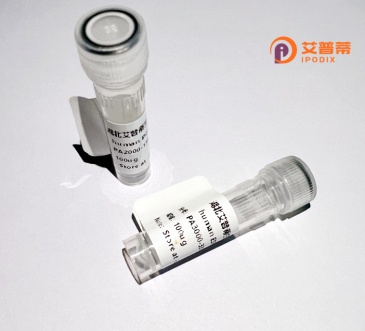
| 纯度 | >90%SDS-PAGE. |
| 种属 | Human |
| 靶点 | SCN2A2 |
| Uniprot No | Q99250 |
| 内毒素 | < 0.01EU/μg |
| 表达宿主 | E.coli |
| 表达区间 | 273-362 aa |
| 活性数据 | NLRNKCLQWPPDNSSFEINITSFFNNSLDGNGTTFNRTVSIFNWDEYIEDKSHFYFLEGQNDALLCGNSSDAGQCPEGYICVKAGRNPNY |
| 分子量 | 35.64 kDa |
| 蛋白标签 | GST-tag at N-terminal |
| 缓冲液 | PBS, pH7.4, containing 0.01% SKL, 1mM DTT, 5% Trehalose and Proclin300. |
| 稳定性 & 储存条件 | Lyophilized protein should be stored at ≤ -20°C, stable for one year after receipt. Reconstituted protein solution can be stored at 2-8°C for 2-7 days. Aliquots of reconstituted samples are stable at ≤ -20°C for 3 months. |
| 复溶 | Always centrifuge tubes before opening.Do not mix by vortex or pipetting. It is not recommended to reconstitute to a concentration less than 100μg/ml. Dissolve the lyophilized protein in distilled water. Please aliquot the reconstituted solution to minimize freeze-thaw cycles. |
以下是3篇与SCN2A(编码Nav1.2钠通道)重组蛋白研究相关的文献(注:SCN2A2可能为笔误,暂按SCN2A解析):
---
1. **文献名称**: *"Structure and function of the human NaV1.2 channel"*
**作者**: Shen H. et al.
**摘要**: 通过HEK细胞系统重组表达了人源SCN2A编码的Nav1.2钠通道,结合冷冻电镜解析了其三维结构(分辨率3.0 Å),并揭示了电压门控及β亚基调控的分子机制,为癫痫相关突变的功能研究提供了结构基础。
2. **文献名称**: *"Pathogenic SCN2A variants cause epileptic encephalopathy via altered channel trafficking"*
**作者**: Sugiura Y. et al.
**摘要**: 通过体外表达携带自闭症/癫痫相关突变(如R853Q)的重组Nav1.2蛋白,发现突变导致通道膜运输障碍及电流幅值降低,解释了SCN2A功能丧失型突变引发早期婴儿癫痫的分子机制。
3. **文献名称**: *"Pharmacological targeting of NaV1.2 accelerates seizure onset in Dravet syndrome model"*
**作者**: Gazina E.V. et al.
**摘要**: 利用重组Nav1.2蛋白的电生理筛选平台,验证了抗癫痫药物丙戊酸对该通道的抑制作用,揭示了其在SCN2A功能亢进突变中的潜在治疗应用,并探讨了不同钠通道亚型的选择性调控策略。
---
**注**:若需具体文献DOI或出版年份,请提供更详细的关键词,部分研究可能与Nav1.1(SCN1A)或其它钠通道亚型有交叉,建议通过PubMed/Google Scholar核实原文。
The SCN2A gene encodes the Nav1.2 protein, a voltage-gated sodium channel α-subunit critical for neuronal electrical signaling. Predominantly expressed in the central nervous system, Nav1.2 facilitates the initiation and propagation of action potentials, particularly in unmyelinated axons and developing neurons. Structurally, it consists of four homologous domains with six transmembrane segments each, featuring voltage-sensing and pore-forming regions.
SCN2A mutations are linked to neurodevelopmental disorders, including epilepsy (e.g., Dravet syndrome), autism spectrum disorder, and intellectual disability. These variants alter channel kinetics—affecting activation, inactivation, or conductance—leading to neuronal hyperexcitability or dysfunction. Notably, gain-of-function mutations often correlate with early-onset seizures, while loss-of-function variants associate with autism.
Recombinant human Nav1.2 protein, typically produced in heterologous systems (e.g., HEK293 cells), enables mechanistic studies of channelopathies and drug screening. Its purification allows electrophysiological characterization (patch-clamp) and structural analyses (cryo-EM), advancing therapeutic discovery. Research on this protein enhances understanding of neuronal excitability mechanisms and precision medicine approaches for SCN2A-related disorders.
×